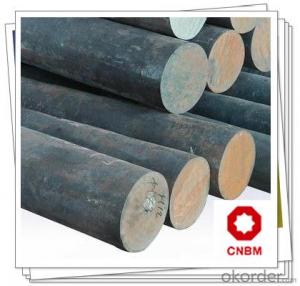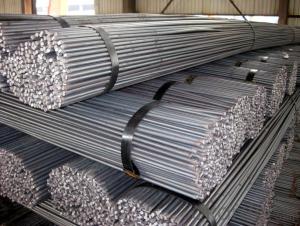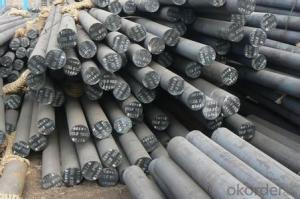Hot Rolled Carbon Steel Round Bars S20C
- Loading Port:
- Shanghai
- Payment Terms:
- TT OR LC
- Min Order Qty:
- 50 m.t.
- Supply Capability:
- 120000 m.t./month
OKorder Service Pledge
OKorder Financial Service
You Might Also Like
Hot Rolled Carbon Steel Round Bars S20C
Product Specification
1, Chemical Composition %
| Grade | C | Si | Mn | S | P | Cr | Ni | Cu |
| S20C | 0.08-0.23 | 0.15-0.35 | 0.30-0.60 | ≤0.030 | ≤0.030 | ≤0.20 | ≤0.25 | ≤0.25 |
2, Mechanical Properties
| Strength of Extension σb | Yield Strength σs | Elogation δ5 |
| ≥245 Mpa | ≥245 Mpa | ≥28% |
3, Diameter: 16mm - 300mm
Length: Max 12m
Application
Can be used to manufacture all kinds of machine parts with high tenacity but won't be subjected to large stress.
Can be used to manufacture carburizing and carbonitriding parts with high surface hardness in general machinery and automobile, agricultural machinery.
Product Main Points
1, Heat Treatment: normalizing, annealing, tempering, quenching
2, Surface Treatment: black, grinding, bright, polish
3, Product Process: hot rolled, cold drawn, forged
FAQ
1, Payment Terms:
30% T/T deposit & 70% T/T before delivery.
Irrevocable L/C at sight
2, Trade Terms:
EXW, FOB, CIF, CNF
3, Delivery Time:
Normally 30-40 days. According to quantity.
4, Manufacture or Trading Company:
CNBM is a state-owned fortune global 500 trading company. We have intergrated supply system.
There are about 20 overseas locations in different countries.
Product Show

Work Shop
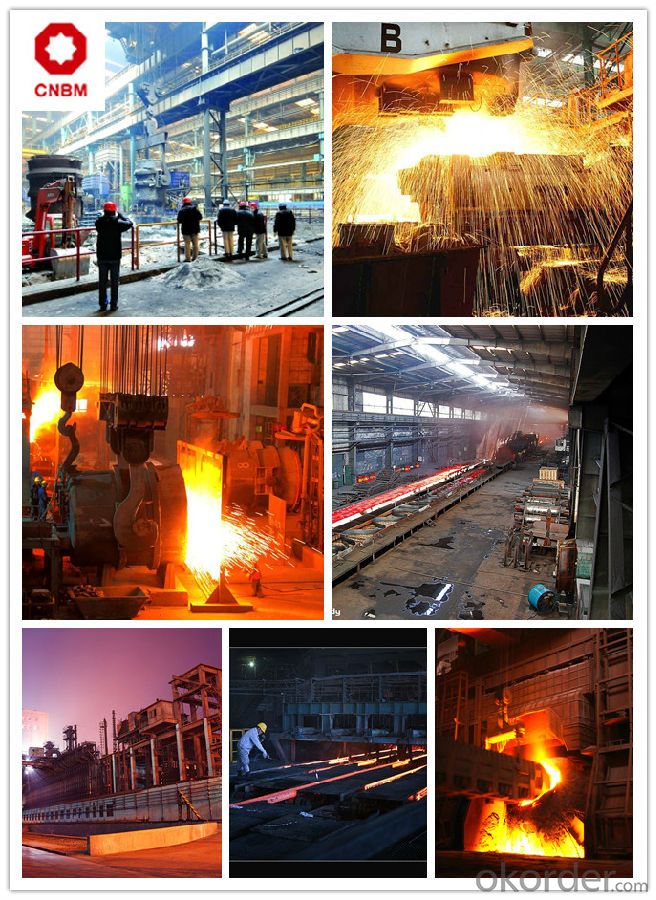
About Us

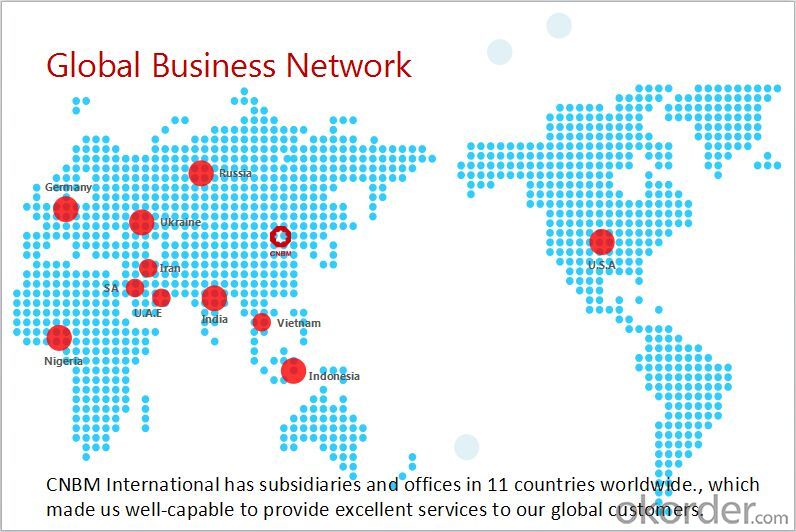
- Q:Can steel round bars be used for shafts or axles?
- Indeed, shafts or axles can make use of steel round bars. In a multitude of industries, including automotive, machinery, and construction, steel round bars are frequently employed due to their robustness, longevity, and adaptability. Their selection for shafts or axles often stems from their capacity to endure substantial loads, furnish dependable support, and endure wear and tear. By virtue of being machinable and amenable to heat treatment, steel round bars can be customized to meet specific prerequisites, rendering them well-suited for deployment as shafts or axles in a wide range of applications where strength and dependability are paramount, such as vehicles, industrial apparatus, and rotating machinery.
- Q:What is the modulus of elasticity of a steel round bar?
- The modulus of elasticity of a steel round bar typically ranges from 190 to 210 gigapascals (GPa).
- Q:How do you measure the straightness tolerance of a steel round bar?
- To measure the straightness tolerance of a steel round bar, you can use a variety of methods depending on the accuracy and precision required. Here are a few common techniques: 1. Visual Inspection: This is a simple method where you visually inspect the bar for any visible deviations from straightness. You can place the bar on a flat surface and look for any bends or curves along its length. However, this method is subjective and may not provide precise measurements. 2. Straightedge Method: In this method, you place a straightedge, such as a ruler or a precision straightedge, against the bar's surface and check for any gaps or spaces between the straightedge and the bar. This method provides a more accurate measurement but can still be influenced by human error. 3. Dial Indicator Method: This method involves using a dial indicator, which is a precision measuring tool, to measure the straightness tolerance. You secure the dial indicator to a fixed point and then move it along the length of the bar, noting any deviations from a straight line. This method provides more precise measurements and can be used to quantify the straightness tolerance in terms of a specific unit of measurement, such as inches or millimeters. 4. Laser Measurement: Laser systems, such as laser alignment devices, can be used to measure the straightness tolerance of a steel round bar. These systems use lasers to project a straight line onto the surface of the bar and then measure any deviations from this line. Laser measurement provides highly accurate and repeatable results, making it suitable for applications that require tight tolerances. It is important to note that the choice of measurement method depends on the required accuracy, the size of the round bar, and the available resources and equipment. Additionally, it is recommended to consult industry standards and guidelines to ensure compliance with specific tolerances and requirements for your application.
- Q:How do you determine the strength of a steel round bar?
- Various methods can be used to determine the strength of a steel round bar, including physical testing and material specifications. One commonly used method involves conducting a tensile test, where the bar is pulled until it breaks. This test helps determine the ultimate tensile strength (UTS) of the steel, which is the maximum stress it can handle before fracturing. The UTS is typically measured in units of force per cross-sectional area, such as pounds per square inch (psi) or megapascals (MPa). Another important strength property to consider is the yield strength. This is the stress level at which the steel starts to permanently deform, without any increase in load. The yield strength is crucial in assessing the structural integrity of the bar, as it indicates the maximum load it can bear without undergoing plastic deformation. In addition to physical testing, the strength of a steel round bar can also be determined by examining its material specifications. Steel manufacturers provide information about the composition and mechanical properties of their products. This includes details about the steel grade, which indicates the alloying elements present in the steel and their concentrations. Different steel grades have varying strength properties, which can help assess the strength of the round bar. It is important to consider that factors like heat treatment or surface conditions can also influence the strength of a steel round bar. Heat treatment processes, such as quenching and tempering, can enhance the strength and hardness of the steel. Additionally, surface conditions like coatings or treatments can improve corrosion resistance. To accurately determine the strength of a steel round bar, it is recommended to consult the material specifications provided by the manufacturer and, if necessary, conduct physical tests like tensile testing.
- Q:Are steel round bars suitable for structural applications?
- Yes, steel round bars are suitable for structural applications. They are commonly used in construction, engineering, and manufacturing industries for various structural purposes due to their high strength, durability, and versatility. Steel round bars provide excellent support and reinforcement in buildings, bridges, machinery, and other structural components.
- Q:What are the different surface treatments for steel round bars?
- There are several different surface treatments available for steel round bars, each serving a specific purpose and providing unique benefits. Some of the most common surface treatments for steel round bars include: 1. Hot-dip galvanizing: This process involves immersing the steel round bars in a bath of molten zinc, which creates a protective coating that helps prevent corrosion and rusting. Hot-dip galvanizing is an effective treatment for steel round bars used in outdoor or corrosive environments. 2. Painting: Applying a coat of paint to the surface of steel round bars not only enhances their appearance but also provides a protective barrier against moisture and oxidation. Painting is commonly used for decorative purposes or when a specific color is desired. 3. Powder coating: Powder coating involves applying a dry powder to the steel round bars, which is then cured under heat to form a durable and attractive finish. This treatment offers excellent resistance to impact, chemicals, and UV rays, making it suitable for various applications. 4. Electropolishing: This process uses an electric current and an electrolyte solution to remove a thin layer of the steel round bars' surface, resulting in a smooth and shiny finish. Electropolishing improves the appearance and corrosion resistance of the steel, making it ideal for applications that require a high level of cleanliness and aesthetics. 5. Passivation: Passivation involves treating the steel round bars with an acid solution to remove any free iron or iron oxide from the surface, thus enhancing their corrosion resistance. Passivation is commonly used for stainless steel round bars to increase their longevity and prevent staining or rusting. 6. Shot blasting: Shot blasting is a mechanical surface treatment that involves bombarding the steel round bars with small steel balls or particles at high velocity. This process removes any surface contaminants, scale, or rust, resulting in a clean and roughened surface that improves adhesion for subsequent coatings or treatments. 7. Chrome plating: Chrome plating is a technique where a thin layer of chromium is electroplated onto the surface of steel round bars. This treatment provides excellent corrosion resistance, wear resistance, and a shiny appearance, making it suitable for applications that require durability and aesthetics. Overall, the choice of surface treatment for steel round bars depends on the specific requirements of the application, such as corrosion resistance, aesthetics, or wear resistance. It is important to carefully consider the intended use and environmental conditions before selecting the most appropriate surface treatment for steel round bars.
- Q:What are the different types of steel round bar surface finishes for improved cleanliness?
- Different surface finishes can be used on steel round bars to enhance cleanliness. Here are some examples: 1. Achieving a bright surface finish involves polishing the steel round bar, resulting in a smooth and reflective appearance. This type of finish is commonly utilized in industries where cleanliness and aesthetics are crucial, such as the manufacturing of kitchen appliances or decorative items. 2. A satin finish can be achieved by brushing the steel round bar with fine abrasive pads, resulting in a smooth and matte surface. This finish is often preferred in applications that require a clean and modern look, like architectural designs or furniture manufacturing. 3. The pickled finish involves immersing the steel round bar in an acid solution, which eliminates impurities and oxides from the surface. This type of finish is commonly used in applications where the steel round bar will undergo further processing, such as the production of pipes or tubes. 4. To obtain a passivated finish, the steel round bar is treated with a chemical solution that forms a protective oxide layer on the surface. Passivated finishes enhance the steel's corrosion resistance, making it suitable for use in harsh or corrosive environments. 5. The shot blasted finish involves propelling small metal or ceramic particles at high velocity onto the surface of the steel round bar. This process removes scale, rust, or surface contaminants, resulting in a clean and textured surface. Shot blasted finishes are often employed when a strong bond between the steel round bar and another material, such as paint or coating, is required. Ultimately, the choice of surface finish for steel round bars depends on the specific application and the desired level of cleanliness. Each finish offers distinct properties and advantages, allowing for improved cleanliness and performance in various industries.
- Q:What are the different grades of tool steel round bars?
- Tool steel round bars are available in various grades, each offering unique properties and characteristics to suit specific applications. Some of the different grades of tool steel round bars include: 1. W1: This is a water-hardening tool steel with relatively low carbon content. It is known for its excellent toughness and good wear resistance. W1 tool steel round bars are commonly used for cutting tools and woodworking tools. 2. O1: O1 tool steel round bars are oil-hardening tool steel with high carbon content. They have good wear resistance, high toughness, and excellent dimensional stability. O1 tool steel is often used for punches, dies, and cutting tools. 3. A2: A2 tool steel round bars are air-hardening tool steel with medium carbon and chromium content. They offer good wear resistance, excellent toughness, and high dimensional stability. A2 tool steel is commonly used for blanking and forming dies, as well as shear blades. 4. D2: D2 tool steel round bars are high-carbon, high-chromium tool steel with excellent wear resistance and good toughness. They offer high resistance to abrasive wear and are often used for making cutting tools, punches, and forming dies. 5. M2: M2 tool steel round bars are high-speed steel with a significant amount of tungsten, molybdenum, and vanadium. They have exceptional wear resistance, high red hardness, and good toughness. M2 tool steel is typically used for high-speed cutting tools, drill bits, and machining tools. 6. S7: S7 tool steel round bars are air-hardening shock-resistant tool steel. They have high impact toughness, good wear resistance, and excellent heat resistance. S7 tool steel is commonly used for applications that require high shock resistance, such as chisels and hammers. These are just a few examples of the different grades of tool steel round bars available in the market. The choice of grade depends on factors such as the specific application, desired hardness, wear resistance, toughness, and heat resistance required. It is important to consult with a knowledgeable supplier or metallurgist to determine the most suitable grade for a particular application.
- Q:Can steel round bars be coated for added protection?
- Steel round bars can indeed be coated to provide additional protection. Coating these bars is effective in boosting their resistance to corrosion, wear and tear, as well as other environmental factors that may cause deterioration or damage. There are multiple coating options available for steel round bars, including hot-dip galvanizing, epoxy coating, powder coating, and zinc plating. These coatings create a protective layer that acts as a barrier between the steel and its surroundings, thus preventing direct contact with corrosive substances or abrasive elements. By coating steel round bars, not only does their lifespan and durability increase, but their aesthetic appearance also improves. The choice of coating depends on the specific application, environment, and desired level of protection.
- Q:What are the safety precautions when handling steel round bars?
- When handling steel round bars, it is important to follow certain safety precautions. These include wearing appropriate personal protective equipment such as safety gloves, goggles, and steel-toed boots to protect against potential injuries. Additionally, workers should be trained on the correct lifting techniques to avoid strains or back injuries. It is crucial to inspect the bars for any defects or damages before handling them, as flawed bars can pose safety risks. Proper storage and handling techniques should be followed to prevent accidents such as tripping or falling. Lastly, communication and coordination among workers are essential to ensure a safe working environment when handling steel round bars.
1. Manufacturer Overview |
|
|---|---|
| Location | |
| Year Established | |
| Annual Output Value | |
| Main Markets | |
| Company Certifications | |
2. Manufacturer Certificates |
|
|---|---|
| a) Certification Name | |
| Range | |
| Reference | |
| Validity Period | |
3. Manufacturer Capability |
|
|---|---|
| a)Trade Capacity | |
| Nearest Port | |
| Export Percentage | |
| No.of Employees in Trade Department | |
| Language Spoken: | |
| b)Factory Information | |
| Factory Size: | |
| No. of Production Lines | |
| Contract Manufacturing | |
| Product Price Range | |
Send your message to us
Hot Rolled Carbon Steel Round Bars S20C
- Loading Port:
- Shanghai
- Payment Terms:
- TT OR LC
- Min Order Qty:
- 50 m.t.
- Supply Capability:
- 120000 m.t./month
OKorder Service Pledge
OKorder Financial Service
Similar products
New products
Hot products
Related keywords
